Microstructure, Tribological, and Corrosion Behavior of HVOF-Sprayed (Cr3C2-NiCr+Ni) Coatings on Ductile Cast Iron
Abstract
:1. Introduction
2. Materials and Methods
2.1. Materials
2.2. Coating Deposition
2.3. Microstructure Characterization
2.4. Mechanical and Tribological Properties
2.5. Corrosion Test
3. Results and Discussion
3.1. Characterization of Coating Systems
| Indenter Print Image | Load (N) | HIT (GPa) | EIT (GPa) | KIC (MN m−3/2) | Average KIC (MN m−3/2) |
|---|---|---|---|---|---|
 | 5 | 9.30 | 190.11 | No cracks | |
| 10.12 | 194.15 | ||||
| 10.36 | 200.94 | ||||
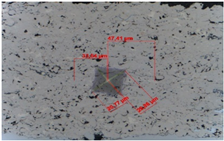 | 10 | 10.45 | 184.16 | 2.06 | 2.37 ± 0.06 |
| 9.86 | 180.94 | 2.59 | |||
| 8.23 | 177.20 | 2.45 | |||
 | 15 | 9.86 | 166.68 | 0.92 | 1.29 ± 0.09 |
| 9.07 | 166.26 | 1.45 | |||
| 9.54 | 168.16 | 1.52 | |||
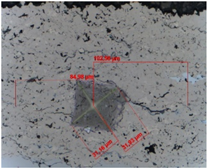 | 20 | 9.22 | 168.04 | 0.88 | 0.81 ± 0.01 |
| 8.56 | 165.33 | 0.81 | |||
| 9.19 | 159.42 | 0.73 |
| Indenter Print Image | Load (N) | HIT (GPa) | EIT (GPa) | KIC (MN m−3/2) | Comments |
|---|---|---|---|---|---|
 | 5 | 8.76 | 187.86 | 3.24 | Matrix |
 | 3.42 | 143.44 | No cracks | ||
 | 5.13 | 165.58 | No cracks | ||
 | 10 | 9.75 | 178.15 | 2.71 | Matrix |
 | 5.04 | 166.77 | 1.84 | Ni-particle | |
 | 6.53 | 163.84 | No cracks | ||
 | 15 | 9.67 | 165.56 | 1.89 | Matrix |
 | 6.43 | 154.99 | 1.15 | Ni-particle | |
 | 4.82 | 145.01 | 1.05 | Interface |
3.2. Wear and Friction Behavior
3.3. Corrosion Behavior
4. Conclusions
- The composite coating (Cr3C2-NiCr+Ni), applied using the HVOF technique, exhibits a dense, layered microstructure with no visible defects at the interface between the coating and substrate. The microstructure contains elongated, plastically deformed Ni-Cr alloy particles, fine Cr3C2 particles (ranging from 0.5 to 2.5 µm), and partially molten nickel particles with a flattened shape. Phase analysis identified the presence of Cr7C3 and Ni3Cr phases, which contribute to the reinforcement of the nickel–chromium matrix. The relatively low decomposition of Cr3C2 into Cr7C3 (8.3%) indicates the carbide’s high chemical stability during the spraying process.
- The modification of the coating composition by adding nickel particles improves its mechanical, tribological, and corrosion properties. The reduction of microhardness (HIT) and the modulus of elasticity (EIT) increases the plasticity of the coating, limiting crack propagation and delaying the delamination process, which improves its structural integrity. The presence of nickel particles strengthens the coating due to synergistic interaction with Cr3C2, resulting in increased resistance to mechanical wear and scratches. The coating also demonstrates improved corrosion resistance due to the formation of protective oxide layers (NiO).
- (Cr3C2-NiCr+Ni) coatings deposited on cast iron substrates by the HVOF method are an effective solution for applications requiring high mechanical strength, resistance to cracking, wear and corrosion. The synergistic effect between hard chromium carbide particles and ductile nickel particles ensures high operating efficiency, especially in environments exposed to intense mechanical and corrosive impacts.
Author Contributions
Funding
Institutional Review Board Statement
Informed Consent Statement
Data Availability Statement
Conflicts of Interest
References
- Davis, J.R. Handbook of Thermal Spray Technology; ASM International: Davis, CA, USA, 2004. [Google Scholar]
- Pawlowski, L. The Science and Engineering of Thermal Spray Coatings; JohnWiley & Sons: NewYork, NY, USA, 2008. [Google Scholar]
- Straffelini, G.; Federici, M. HVOF cermet coatings to improve sliding wear resistance in engineering systems. Coatings 2020, 10, 886. [Google Scholar] [CrossRef]
- Xie, M.; Zhang, S.; Li, M. Comparative investigation on HVOF sprayed carbide-based coatings. Appl. Surf. Sci. 2013, 273, 799–805. [Google Scholar] [CrossRef]
- Reddy, N.C.; Kumar, B.S.A.; Reddappa, H.N.; Ramesh, M.R.; Koppad, P.G.; Kord, S. HVOF sprayed Ni3Ti and Ni3Ti+ (Cr3C2+20NiCr) coatings: Microstructure, microhardness and oxidation behavior. J. Alloys Compd. 2018, 736, 236–245. [Google Scholar] [CrossRef]
- Kunioshi, C.T.; Correa, O.V.; Ramanathan, L.V. High temperature oxidation and erosion-oxidation behaviour of HVOF sprayed Ni-20Cr, WC-20Cr-7Ni and Cr3C2-Ni-20Cr coatings. Surf. Eng. 2006, 22, 121–127. [Google Scholar] [CrossRef]
- Matikainen, V.; Bolelli, G.; Koivuluoto, H.; Sassatelli, P.; Lusvarghi, L.; Vuoristo, P. Sliding wear behaviour of HVOF and HVAF sprayed Cr3C2-based coatings. Wear 2017, 388–389, 57–71. [Google Scholar] [CrossRef]
- Bolelli, G.; Berger, L.M.; Borner, T.; Koivuluoto, H.; Matikainen, V.; Lusvarghi, L.; Lyphout, C.; Markocsan, N.; Nylen, P.; Sassatelli, R.; et al. Sliding and abrasive wear behaviour of HVOF- and HVAF-sprayed Cr3C2-NiCr hardmetal coatings. Wear 2016, 358–359, 32–50. [Google Scholar] [CrossRef]
- Formanek, B.; Szymański, K.; Szczucka-Lasota, B. New generation of protective coatings intended for the power industry. J. Mater. Process. Technol. 2005, 164–165, 850–855. [Google Scholar] [CrossRef]
- Berger, L.M. Application of hardmetals as thermal spray coatings. Int. J. Refract. Met. Hard Mater. 2015, 49, 350–364. [Google Scholar] [CrossRef]
- Jin, D.; Yang, F.; Zou, Z.; Gu, L.; Zhao, X.; Guo, F.; Xiao, P. A study of the zirconium alloy protection by Cr3C2–NiCr coating for nuclear reactor application. Surf. Coat. Technol. 2016, 287, 55–60. [Google Scholar] [CrossRef]
- Venkatesh, L.; Pitchuka, S.B.; Sivakumar, G.; Gundakaram, R.C.; Joshi, S.V.; Samajdar, I. Microstructural response of various chromium carbide based coatings to erosion and nano impact testing. Wear 2017, 386, 72–79. [Google Scholar] [CrossRef]
- Matthews, S.; Berger, L.M. Long-term compositional/microstructural development of Cr3C2-NiCr coatings at 500 °C, 700 °C and 900 °C. Int. J. Refract. Met. Hard Mater. 2016, 59, 1–18. [Google Scholar] [CrossRef]
- Singh, H.; Kaur, M.; Prakash, S. High-temperature exposure studies of HVOF-Sprayed Cr3C2-25 (NiCr)/(WC-Co) Coating. J. Therm. Spray Technol. 2016, 25, 1192–1207. [Google Scholar] [CrossRef]
- Varis, T.; Suhonen, C.; Calonius, O.; Cuban, J.; Pietola, M. Optimization of HVOF Cr3C2–NiCr fatigue performance NiCr coating for increase. Surf. Coat.Technol. 2016, 305, 123–131. [Google Scholar] [CrossRef]
- Prudenziati, M.; Gazzadi, G.C.; Medici, M.; Dalbagni, G.; Caliari, M. Cr3C2-NiCr HVOF-sprayed coatings: Microstructure and properties versus powder characteristics and process parameters. J. Therm. Spray Technol. 2010, 19, 541–550. [Google Scholar] [CrossRef]
- Matthews, S. Carbide dissolution/carbon loss as a function of spray distance in unshrouded/shrouded plasma sprayed Cr3C2-NiCr coatings. J. Therm. Spray Technol. 2015, 24, 552–569. [Google Scholar] [CrossRef]
- Li, C.; Ji, G.; Wang, Y.; Sonoya, K. Dominant effect of carbide rebounding on the carbon loss during high velocity oxy-fuel spraying of Cr3C2-NiCr. Thin Solid Films 2002, 419, 137–143. [Google Scholar] [CrossRef]
- Yuan, J.; Ma, C.; Yang, S.; Yu, Z.; Li, H. Improving the wear resistance of HVOF sprayed WC-Co coatings by adding submicron-sizedWC particles at the splats’ interfaces. Surf. Coat. Technol. 2016, 285, 17–23. [Google Scholar] [CrossRef]
- Roy, M.; Pauschitz, A.; Bernardi, J.; Koch, T.; Franek, F. Microstructure and mechanical properties of HVOF sprayed nanocrystalline Cr3C2-25 (Ni20Cr) coating. J. Therm. Spray Technol. 2006, 15, 372–381. [Google Scholar] [CrossRef]
- Chen, J.; Zhao, X.; Zhou, H.; Chen, J.; An, Y.; Yan, F. Microstructure and tribological property of HVOF sprayed adaptive NiMoAl–Cr3C2–Ag composite coating from 20 °C to 800 °C. Surf. Coat. Technol. 2014, 258, 1183–1190. [Google Scholar] [CrossRef]
- Zhang, Y.; Chong, K.; Liu, Q.; Bai, Y.; Zhang, Z.; Wu, D.; Zou, Y. High-temperature tribological behavior of thermally-treated supersonic plasma sprayed Cr3C2-NiCr coatings. Int. J. Refract. Met. Hard Mater. 2021, 95, 105456. [Google Scholar] [CrossRef]
- Picas, J.A.; Punset, M.; Manergues, E.; Martin, E.; Baile, M.T. Microstructural and tribological studies of as-sprayed and heat-treated HVOF Cr3C2–CoNiCrAlY coatings with a CoNiCrAlY bond coat. Surf. Coat. Technol. 2015, 268, 317–324. [Google Scholar] [CrossRef]
- He, B.; Zhang, L.; Yun, X.; Wang, J.; Zhou, G.; Chen, Z.; Yuan, X. Comparative study of HVOF Cr3C2–NiCr coating with different bonding layer on the interactive behavior of fatigue and corrosion. Coatings 2022, 12, 307–324. [Google Scholar] [CrossRef]
- Janka, L.; Norpoth, J.; Trache, R.; Berge, L.M. Influence of heat treatment on the abrasive wear resistance of a Cr3C2–NiCr coating deposited by an ethene-fuelled HVOF spray process. Surf. Coat. Technol. 2016, 291, 444–451. [Google Scholar] [CrossRef]
- Gariboldi, E.; Rovatti, L.; Lecis, N.; Mondora, L.; Mondora, G.A. Tribological and mechanical behaviour of Cr3C2–NiCr thermally sprayed coatings after prolonged aging. Surf. Coat. Technol. 2016, 305, 83–92. [Google Scholar] [CrossRef]
- Mazaheri, Y.; Malmir, R.; Jalilvand, M.M.; Sheikhi, M.; Heidarpour, A. Mechanical properties and tribological performance of A356/Cr3C2-NiCr surface composite developed by high-velocity oxy-fuel and post friction stir processing treatment. Surf. Interfaces 2022, 28, 101627. [Google Scholar] [CrossRef]
- Wang, K.; Hong, S.; Wei, Z.; Hu, N.; Cheng, J.; Wu, Y. Long-term corrosion behavior of HVOF sprayed Cr3C2-NiCr coatings in sulfide-containing 3.5 wt.% NaCl solution. J. Mater. Res. Technol. 2021, 15, 3122–3132. [Google Scholar] [CrossRef]
- Zavareh, M.A.; Sarhan, A.A.D.; Bushroa, A.R.; Basirun, W.J. The tribological and electrochemical behavior of HVOF-sprayed Cr3C2-NiCr ceramic coating on carbon steel. Ceram. Int. 2015, 41, 5387–5396. [Google Scholar] [CrossRef]
- Magnani, M.; Suegama, P.H.; Espallargas, N.; Fugivara, C.S.; Dosta, S.; Guilemany, J.M.; Benedetti, A.V. Corrosion and wear studies of Cr3C2-NiCr-HVOF coatings sprayed on AA7050 T7 under cooling. J. Therm. Spray Technol. 2009, 18, 353–363. [Google Scholar] [CrossRef]
- Hassanzadeh-Tabrizi, S.A. Precise calculation of crystallite size of nanomaterials: A review. J. Alloys Compd. 2023, 986, 171914. [Google Scholar] [CrossRef]
- Anstis, G.; Chantikul, P.; Lawn, B.; Marshall, D. A Critical Evaluation of Indentation Techniques for Measuring Fracture Toughness: I, Direct Crack Measurements. J. Am. Ceram. Soc. 1981, 64, 533–538. [Google Scholar] [CrossRef]
- ISO 27307:2015; Thermal Spraying-Evaluation of Adhesion/Cohesion of Thermal Sprayed Ceramic Coatings by Transverse Scratch Testing. International Organization for Standardization: Geneva, Switzerland, 2015.
- ASTM A 923; Standard Test Methods for Detecting Detrimental Intermetallic Phase in Duplex Austenitic/Ferritic Stainless Steels. ASTM International: West Conshohocken, PA, USA, 2023.
- Ksiazek, M.; Łyp-Wrońska, K. An HVOF-sprayed (Cr3C2-NiCr+Co) composite coating on ductile cast iron: Microstructure, mechanical properties, and scratch resistance. Materials 2024, 17, 1484. [Google Scholar] [CrossRef] [PubMed]
- Hirota, K.; Mitani, K.; Yoshinaka, M.; Yamaguchi, O. Simultaneous synthesis and consolidation of chromium carbides (Cr3C2, Cr7C3 and Cr23C6) by pulsed electric-current pressure sintering. Mater. Sci. Eng. A 2005, 399, 154–160. [Google Scholar] [CrossRef]
- Konopka, K.; Maj, M.; Kurzydłowski, K.J. Studies of the effect of metal particles on the fracture toughness of ceramic matrix composites. Mater. Charact. 2003, 51, 335–340. [Google Scholar] [CrossRef]
- Bartolome, J.F.; Beltran, J.I.; Gutierrez-Gonzalez, C.F.; Moya, J.S.; Pecharroman, C.; Munoz, M.C. Influence of Ceramic–Metal Interface Adhesion on Crack Growth Resistance of ZrO2–Nb Ceramic Matrix Composites. Acta Mater. 2008, 56, 3358–3366. [Google Scholar] [CrossRef]

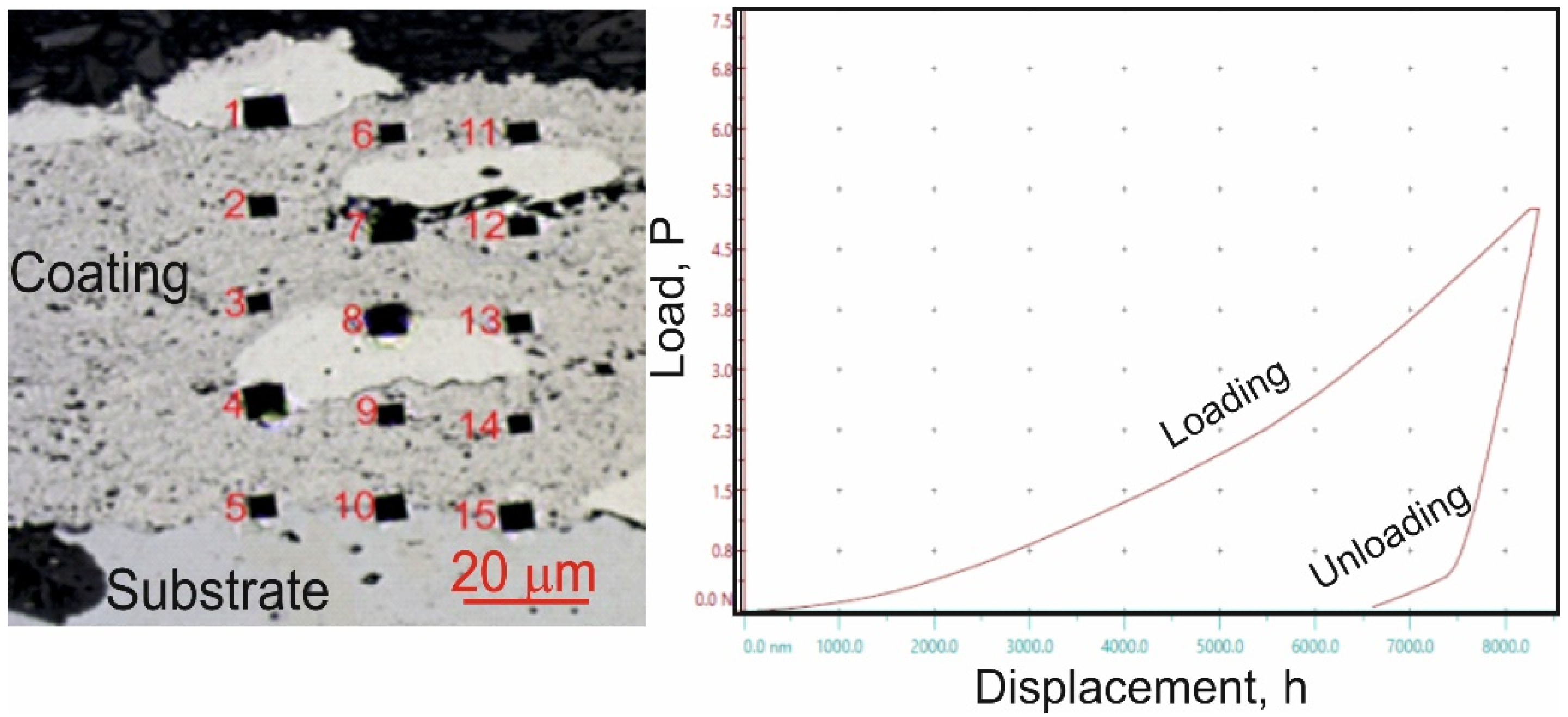
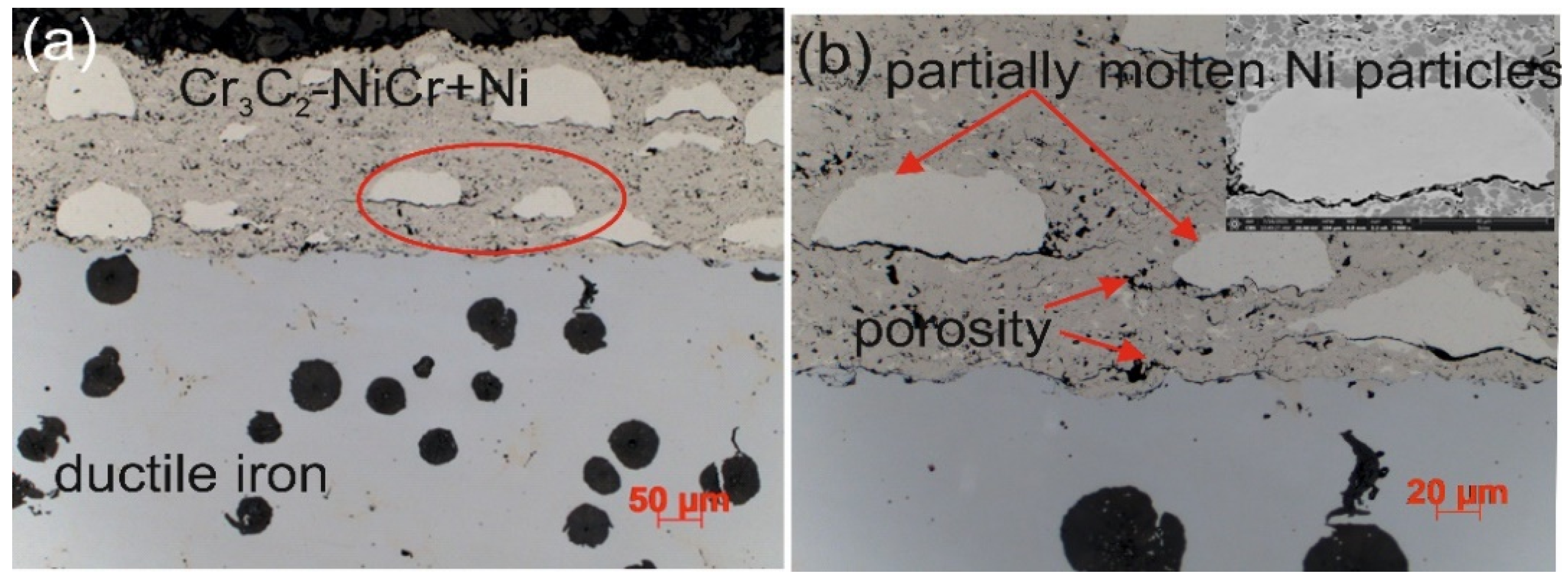


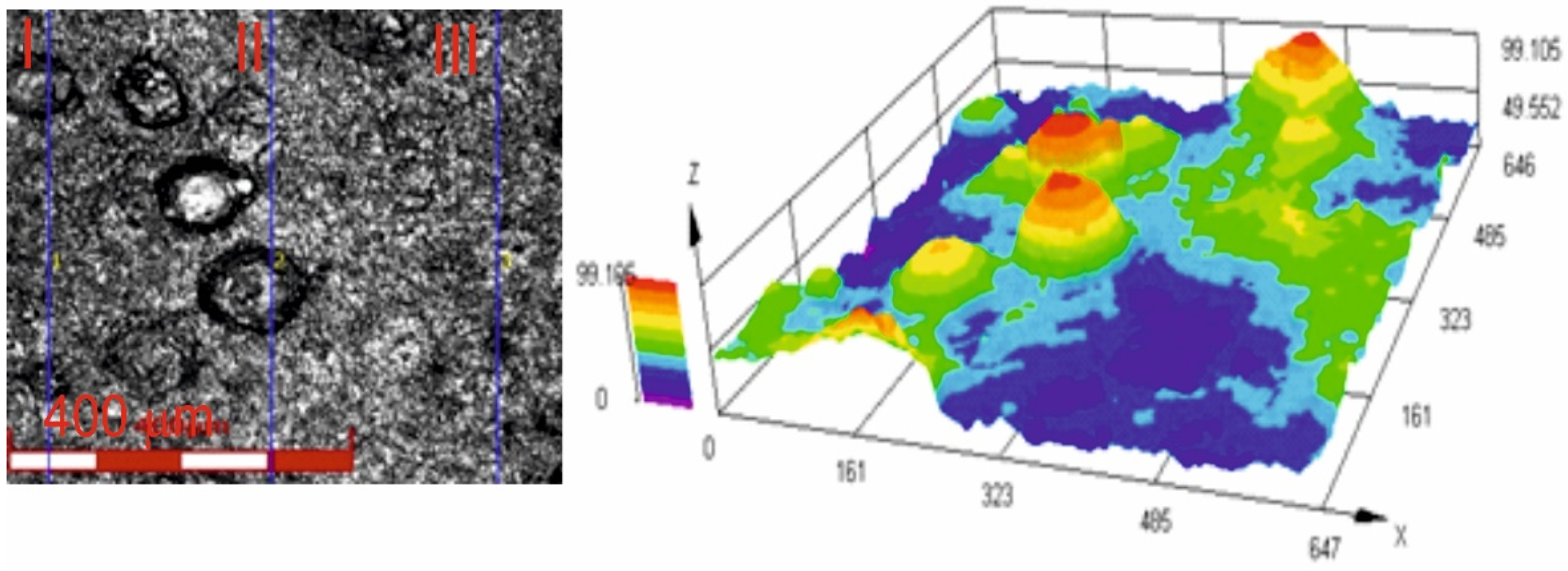
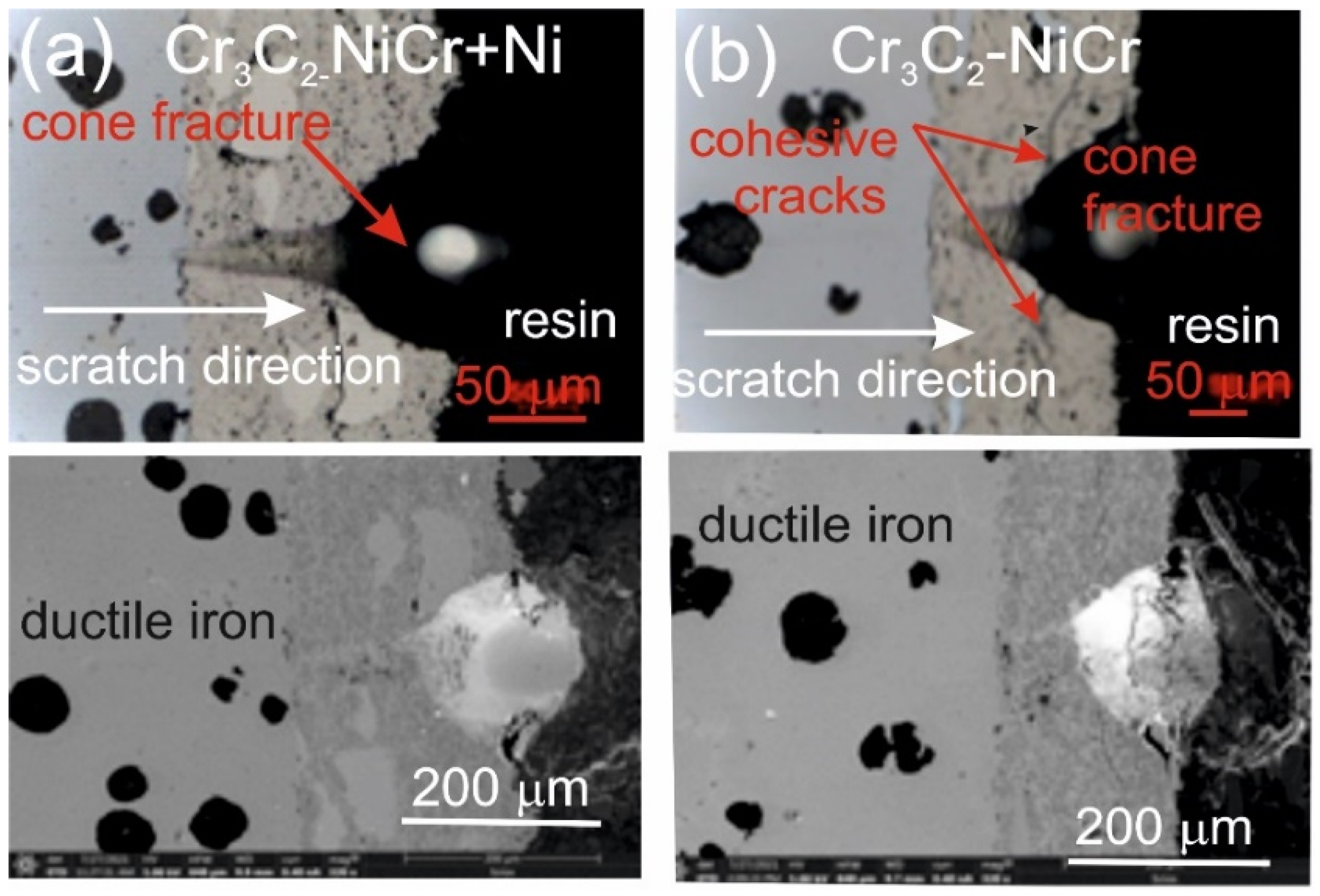
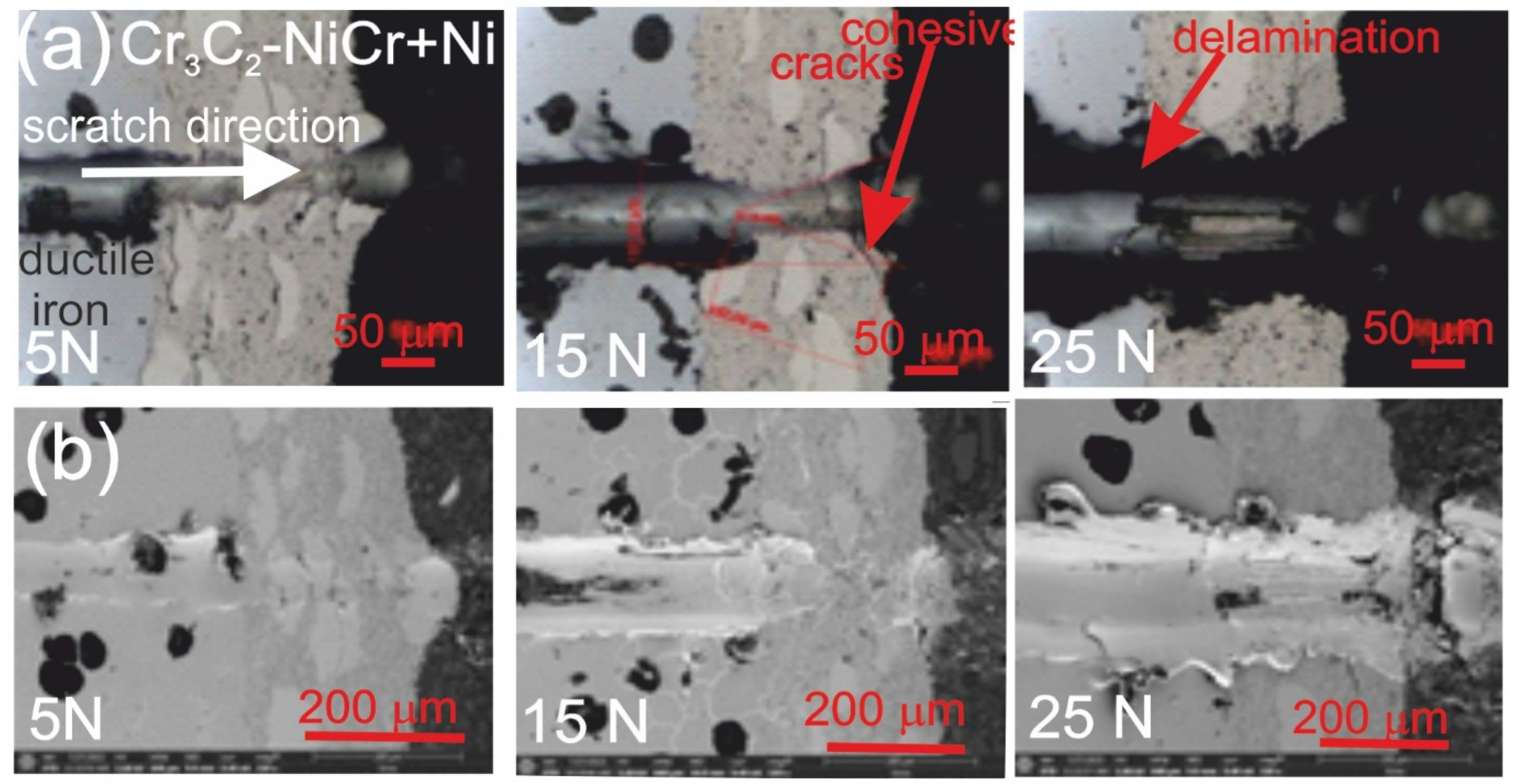
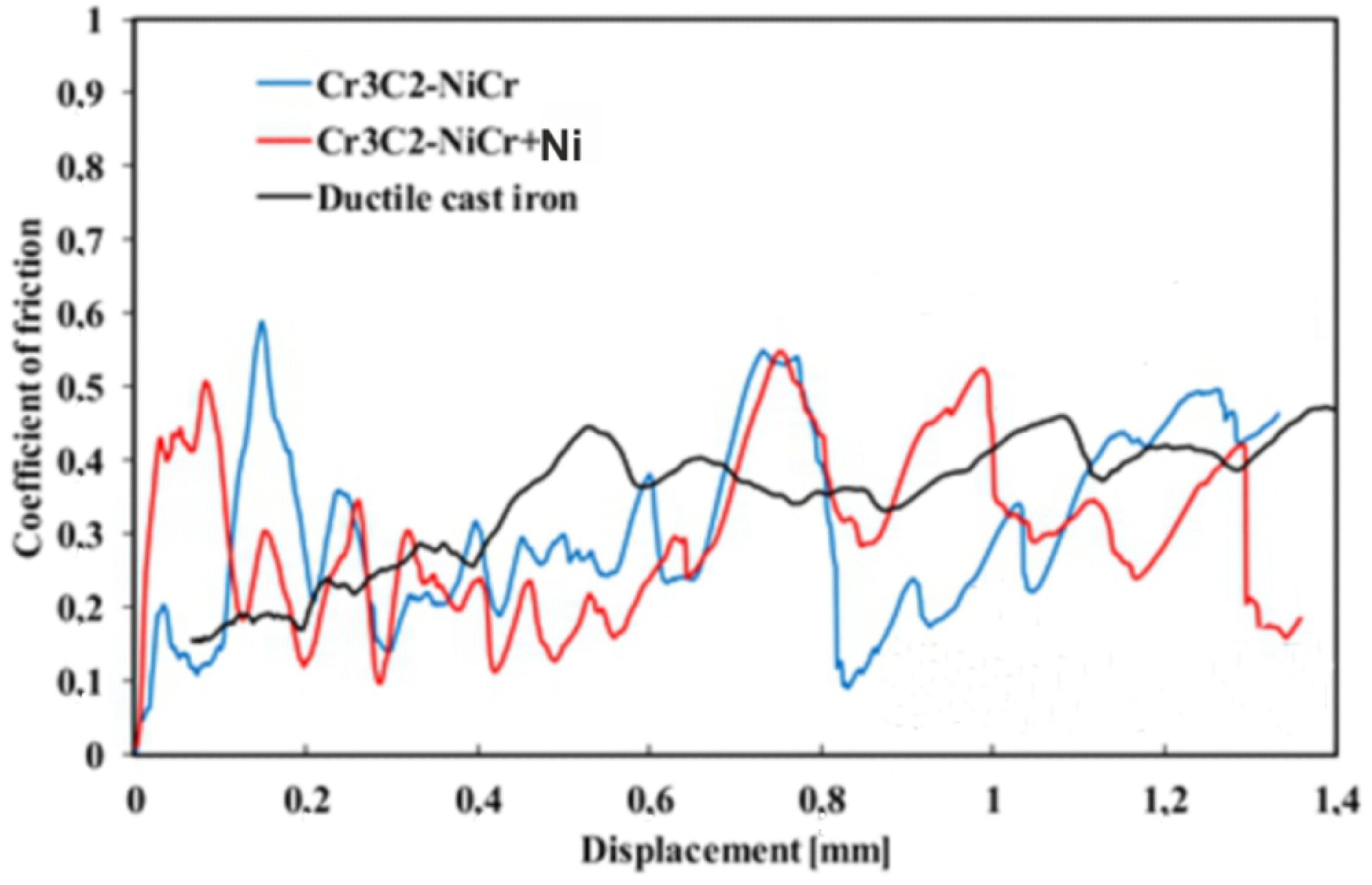

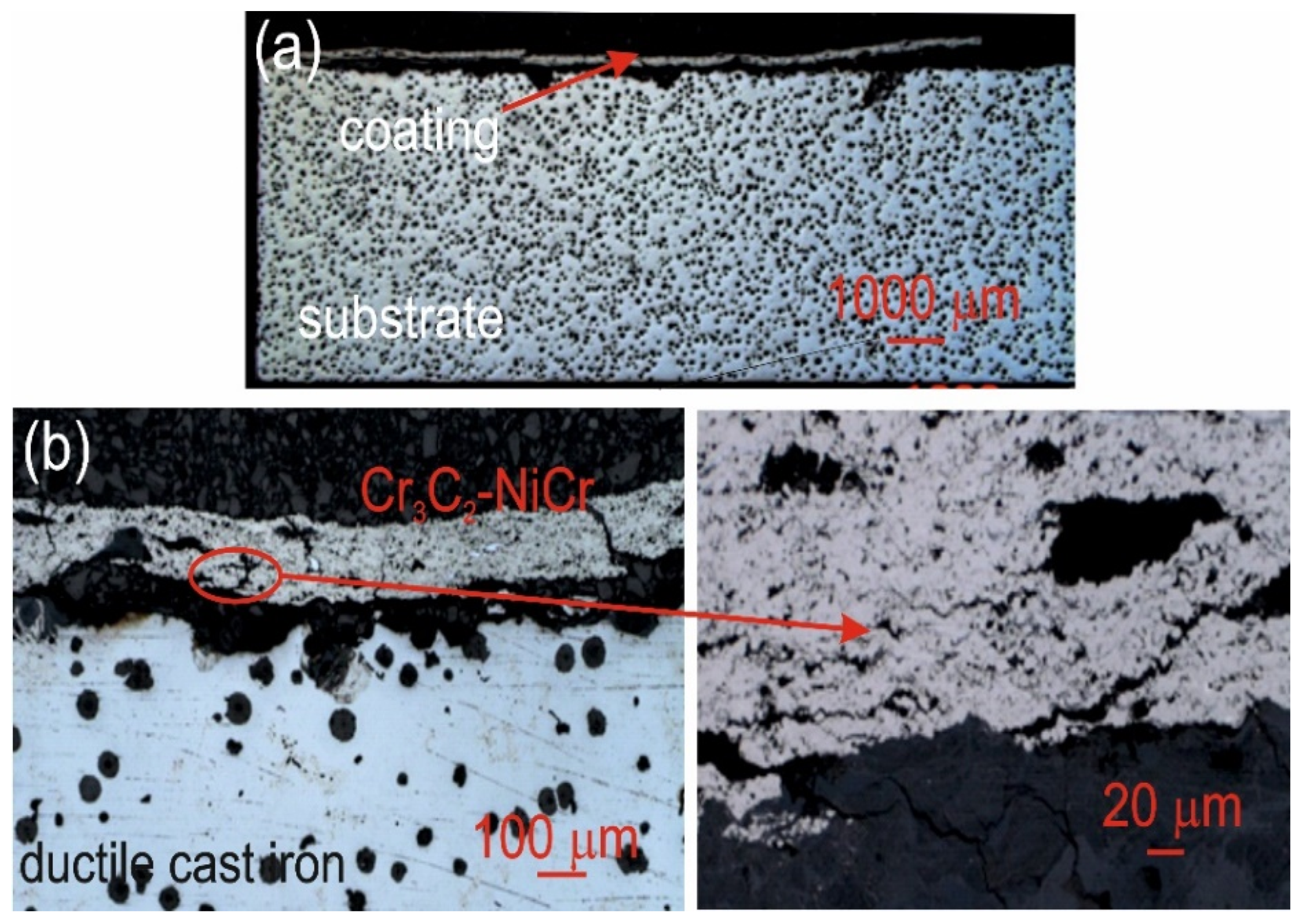
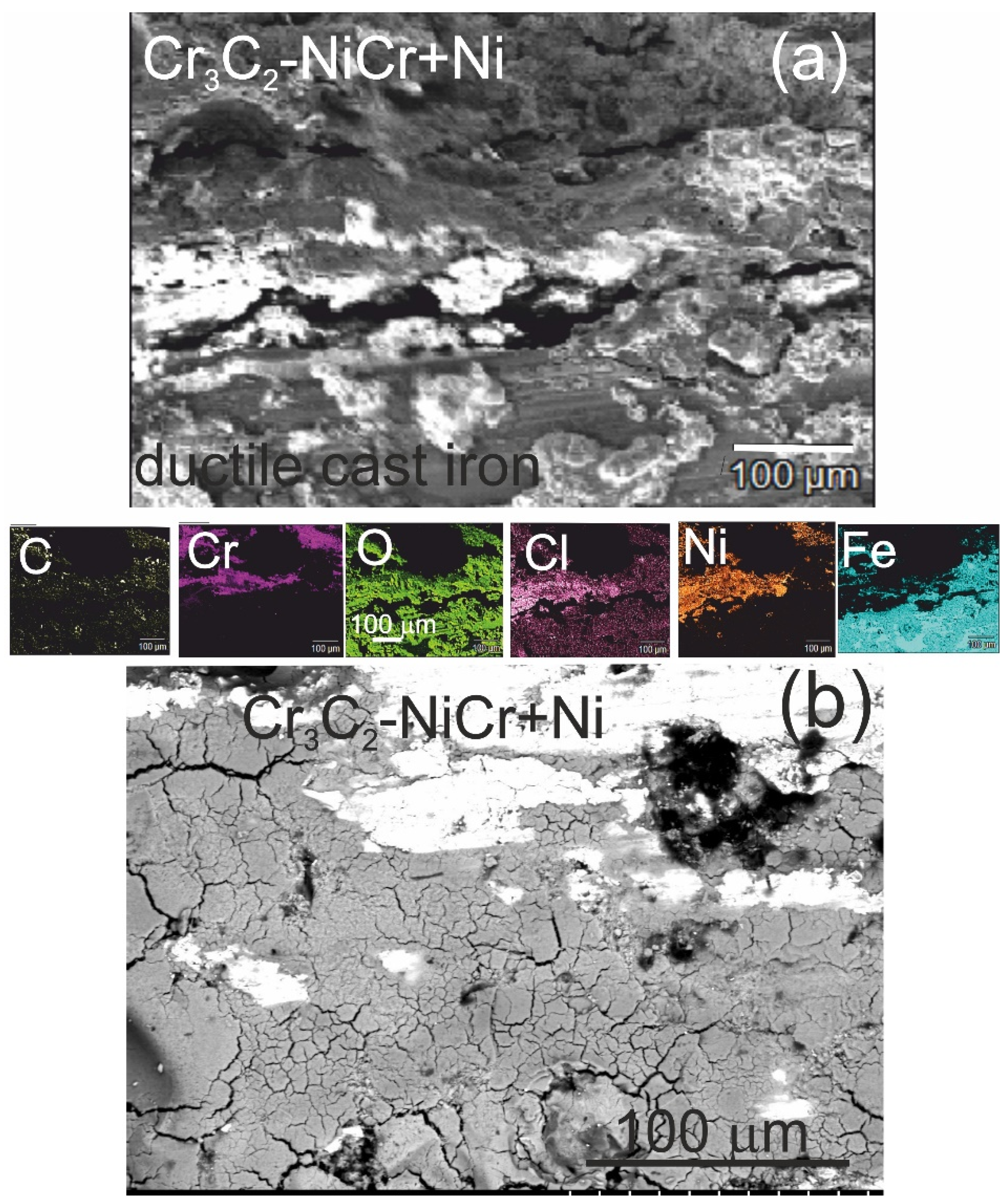

| Chemical Composition, wt.% | |||||||||
|---|---|---|---|---|---|---|---|---|---|
| C | Si | Mn | P | S | Cr | Ni | Mg | Cu | Fe |
| 3.61 | 2.29 | 0.45 | 0.045 | 0.009 | 0.03 | 0.01 | 0.057 | 0.75 | rest |
| Tensile Strength (MPa) | Conventional Yield Point (MPa) | Elongation (%) | Hardness (HB) | Elastic Modulus (GPa) |
|---|---|---|---|---|
| 500 | 340 | 7 | 230 | 169 |
| Gun Movement Speed (mm/s) | Oxygen (L/min) | Kerosene (L/h) | Powder Feed Rate (g/min) | Powder Feed Gas (L/min) | Spraying Distance (mm) |
|---|---|---|---|---|---|
| 583 | 850 | 24 | 65 | Nitrogen, 9.5 | 370 |
| Intender | Scratch Mode | Load (N) | Scratch Length (mm) | Scratch Speed (mm/s) |
|---|---|---|---|---|
| Rockwell C, 100 μm | Continuous load | 5, 10, 15, 20, 25 | 1.4 | 1.2 |
| Progressive load | 0.03–30 | 0.35 | 1.2 |
| Coating | Measurement | Ra (µm) | Rz (µm) |
|---|---|---|---|
| (Cr3C2-NiCr+Ni) | 1 | 9.7 | 41.6 |
| 2 | 14.7 | 69.8 | |
| 3 | 7.9 | 37.3 | |
| Average value (µm) | 10.8 ± 3.5 | 49.6 ± 17.6 |
| Indenter Print Image | Region | HIT (GPa) | EIT (GPa) | Average HIT (GPa) | Average EIT (GPa) |
|---|---|---|---|---|---|
 | Matrix (upper area) | 7.88 | 205.68 | 8.54 ± 0.80 | 193.44 ± 10.93 |
| 9.68 | 194.32 | ||||
| 8.06 | 180.32 | ||||
 | Matrix (center) | 11.54 | 205.68 | 10.11 ± 0.95 | 198.59 ± 13.03 |
| 9.24 | 209.79 | ||||
| 9.56 | 180.32 | ||||
 | Metallic particle | 3.84 | 181.74 | 3.56 ± 0.08 | 151.56 ± 21.75 |
| 3.62 | 141.63 | ||||
| 3.21 | 131.30 | ||||
 | Interface | 8.45 | 208.92 | 7.04 ± 1.39 | 198.15 ± 8.88 |
| 6.73 | 187.16 | ||||
| 5.83 | 198.36 |
| Coating System | Load (N) | |||||
|---|---|---|---|---|---|---|
| 5 | 10 | 15 | 20 | 25 | 0.03–30 | |
| Depth Penetration Pd (μm) | ||||||
| Cr3C2-NiCr/ductile cast iron | 8 | 15 | 22 | 34 | 48 | 37 at approx. 25 N |
| (Cr3C2-NiCr+Ni)/ductile cast iron | 7 | 14 | 21 | 30 | 46 | 41 at approx. 25 N |
| Coating System | Load (N) | Lx (µm) | Ly (µm) | Acn × 10−3 (mm2) |
|---|---|---|---|---|
| (Cr3C2-NiCr+Ni)/ductile cast iron | 5 | - | - | - |
| 10 | 104.12 | 110.46 | 11.51 | |
| 15 | 182.58 | 117.38 | 21.43 | |
| 20 | 206.29 | 217.28 | 44.82 | |
| 25 | delamination |
| Coating System | Load (N) | No Crack (%) | Cohesive Crack (%) | Adhesive Crack (%) | Maximum Load at Which Cohesive Cracks Appears | Maximum Load at Which Adhesive Cracks Appears |
|---|---|---|---|---|---|---|
| Cr3C2-NiCr/ductile cast iron | 5 | 85 | 15 | 0 | over 5 N | |
| 10 | 70 | 30 | 0 | |||
| 15 | 50 | 50 | 0 | |||
| 20 | 0 | 0 | 100 | delamination | ||
| (Cr3C2-NiCr+Ni)/ductile cast iron | 5 | 100 | 0 | 0 | ||
| 10 | 90 | 10 | 0 | over 10 N | ||
| 15 | 80 | 20 | 0 | |||
| 20 | 50 | 50 | 0 | |||
| 25 | 0 | 0 | 100 | delamination |
| Materials | Surface Area (mm2) | Weight Before Test (g) | Weight After Test (g) | Mass Loss (g) | Corrosion Rate (g/m2doba) |
|---|---|---|---|---|---|
| Ductile cast iron | 102 | 25.44750 | 25.42659 | 0.02091 | 205.65 |
| Cr3C2-NiCr/ductile iron | 109 | 25.48380 | 25.47234 | 0.01146 | 105.14 |
| (Cr3C2-NiCr+Ni)/ductile iron | 113 | 27.21759 | 27.21132 | 0.00627 | 55.49 |
Disclaimer/Publisher’s Note: The statements, opinions and data contained in all publications are solely those of the individual author(s) and contributor(s) and not of MDPI and/or the editor(s). MDPI and/or the editor(s) disclaim responsibility for any injury to people or property resulting from any ideas, methods, instructions or products referred to in the content. |
© 2025 by the authors. Licensee MDPI, Basel, Switzerland. This article is an open access article distributed under the terms and conditions of the Creative Commons Attribution (CC BY) license (https://creativecommons.org/licenses/by/4.0/).
Share and Cite
Ksiazek, M.; Boron, L. Microstructure, Tribological, and Corrosion Behavior of HVOF-Sprayed (Cr3C2-NiCr+Ni) Coatings on Ductile Cast Iron. Materials 2025, 18, 1856. https://doi.org/10.3390/ma18081856
Ksiazek M, Boron L. Microstructure, Tribological, and Corrosion Behavior of HVOF-Sprayed (Cr3C2-NiCr+Ni) Coatings on Ductile Cast Iron. Materials. 2025; 18(8):1856. https://doi.org/10.3390/ma18081856
Chicago/Turabian StyleKsiazek, Marzanna, and Lukasz Boron. 2025. "Microstructure, Tribological, and Corrosion Behavior of HVOF-Sprayed (Cr3C2-NiCr+Ni) Coatings on Ductile Cast Iron" Materials 18, no. 8: 1856. https://doi.org/10.3390/ma18081856
APA StyleKsiazek, M., & Boron, L. (2025). Microstructure, Tribological, and Corrosion Behavior of HVOF-Sprayed (Cr3C2-NiCr+Ni) Coatings on Ductile Cast Iron. Materials, 18(8), 1856. https://doi.org/10.3390/ma18081856






